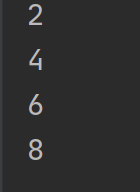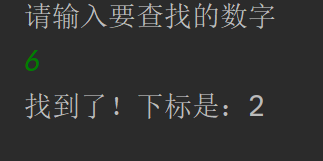table of Contents
4. Array as a method parameter
5. Array as the return value of the method
②Dichotomy finds an element in an ordered array
1. The role of arrays
Allows us to create variables of the same type in batches
2. Array creation
The following three creation methods are all possible
int[] arr1=new int[] {1,2,3,4};
int[] arr2={1,2,3,4};
int[] arr3=new int[4];3. The use of arrays
①Get the length (use .length)
public class Pra0104 {
public static void main(String[] args) {
int[] arr={1,2,3,4};
System.out.println(arr.length);
}
}
②Access elements
By removing the standard access element in the array in such a manner, the note can not be out of range index.
for loop to traverse the array
public class Pra0104 {
public static void main(String[] args) {
int[] arr={1,2,3,4};
for(int i=0;i<arr.length;i++){
System.out.println(arr[i]);
}
}
}for each traverse the array , as follows
public class Pra0104 {
public static void main(String[] args) {
int[] arr={1,2,3,4};
for(int x:arr){
System.out.println(x);
}
}
}operation result:
4. Array as a method parameter
For example:
public class Pra0104 {
public static void main(String[] args) {
int[] arr={1,2,3,4};
printArr(arr);
}
public static void printArr(int[] arr) {
for(int x:arr){
System.out.println(x);
}
}
}operation result:

5. Array as the return value of the method
Example: Multiply each element in the array by 2
public class Pra0104 {
public static void main(String[] args) {
int[] arr1={1,2,3,4};
int[] arr2=transform(arr1);
for(int x:arr2){
System.out.println(x);
}
}
public static int[] transform(int[] arr1) {
int[] arr2=new int[arr1.length];
for(int i=0;i< arr1.length;i++){
arr2[i]=arr1[i]*2;
}
return arr2;
}
}operation result:

6. Array related exercises
①Integer array to string
Code
import java.util.Arrays;
public class Pra0104 {
public static void main(String[] args) {
int[] arr={1,2,3,4};
String str= Arrays.toString(arr);
System.out.println(str);
}
}operation result

②Dichotomy finds an element in an ordered array
Specific ideas, written in the previous C language column
import java.util.Scanner;
public class Pra0104 {
public static void main(String[] args) {
int[] arr={2,4,6,8,10};
find(arr);
}
public static void find(int[] arr) {
System.out.println("请输入要查找的数字");
Scanner sc=new Scanner(System.in);
int find=sc.nextInt();
int left=0;
int right=arr.length-1;
while(left<=right){
int mid=(left+right)/2;
if(find<arr[mid]){
right=mid-1;
}else if(find>arr[mid]){
left=mid+1;
}else{
System.out.println("找到了!下标是:"+mid);
break;
}
}
if(left>right){
System.out.println("找不到!");
}
}
}operation result:

③ Array reverse order
Set two subscripts, left and right
public class Pra0104 {
public static void main(String[] args) {
int arr[]={1,2,3,4};
reverseArr(arr);
//输出逆序后的数组
for(int x:arr){
System.out.println(x);
}
}
public static void reverseArr(int[] arr) {
int left=0;
int right=arr.length-1;
while(left<right){
int temp=arr[left];
arr[left]=arr[right];
arr[right]=temp;
left++;
right--;
}
}
}operation result:

④Check the order of the array
Here to check whether the array is in ascending order, return true or false
public class Pra0104 {
public static void main(String[] args) {
int[] arr={1,2,3,4};
System.out.println(isOrder(arr));
}
public static boolean isOrder(int[] arr) {
for(int i=0;i<arr.length-1;i++){
if(arr[i]>arr[i+1]){
return false;
}
}
return true;
}
}operation result:

⑤ Array copy
Implement your own copy method
public class Pra0104 {
public static void main(String[] args) {
int[] arr={1,2,3,4};
int[] newArr=copy(arr);
for(int x:newArr){
System.out.println(x);
}
}
public static int[] copy(int[] arr) {
int[] ret=new int[arr.length];
for(int i=0;i<arr.length;i++){
ret[i]=arr[i];
}
return ret;
}
}operation result:

Use the library
import java.util.Arrays;
public class Pra0104 {
public static void main(String[] args) {
int[] arr={1,2,3,4};
int[] newArr=Arrays.copyOf(arr,arr.length);
System.out.println(Arrays.toString(newArr));
}
}operation result:

Note: When copying, there may be questions, why not just int[] newArr=arr? This is because this direct assignment is equivalent to another alias to the original array, newArr points to the array pointed to by arr, so the actual array is still the same, and the copy effect is not achieved, as shown in the figure below

